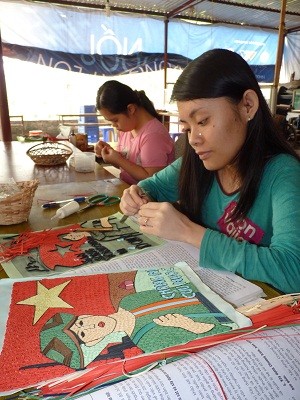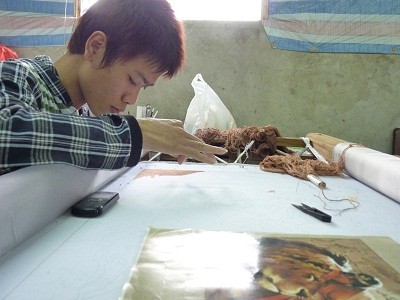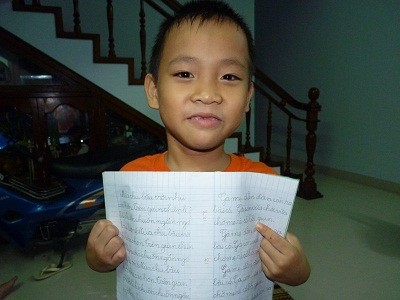Hello and welcome to the Sunday show, our biggest feature of the week on Voice of Vietnam Radio showcasing Vietnam’s traditional culture, hospitable people, beautiful landscapes and more. I’m…… I’ll be hosting the show today, and I hope you enjoy it.
Most young people and children with disabilities in Vietnam come from vulnerable households. Their families are poor. And having a child with a disability has put even more pressure on their families. In today’s show, we take a closer look at efforts to integrate young people with disabilities into the Vietnamese society.
Lunchtime in Hanoi. A group of teenagers are munching away happily on their rice. They’re sitting at a long table underneath a wooden roof in the middle of a large courtyard, surrounded by lush plants and flowers. At first sight, this could be a regular school break. But then you notice the wheelchairs and crutches, and that some are chattering away whilst others are totally silent. Welcome to “Hold the future”.
After lunch, the teenagers at “Hold the future” return to their workplace. Dao Thi Thu Hien and Nguyen Thi Mai are sitting next to each other in the courtyard, making colourful pictures with what is called the quilling technique. Mai has down syndrome. She rolls strips of paper which Hien then glues together on a piece of parchment.
 |
| Hien and Mai are rolling paper to make pictures |
In an adjacent building, a group of teenage boys and girls are sitting quietly on the floor, diligently folding silk cloth flowers. Most of them are hearing impaired. In the far end corner of the room, 17 year-old Nguyen Van Hung is quickly pulling thread through linen parchment.
 |
| Hung produces an embroidered picture |
Like most of his colleagues in the room, Hung cannot hear or speak. But he quickly mastered the art of embroidery and was recently awarded first prize in a national embroidery competition, says his teacher, Thai Van Tang:“It was very difficult at first to teach the hearing-impaired students as I had to learn the sign language to teach them how to sew, how to choose the colors of the threads and how to combine the colors together. But the students learn quickly. In case they don’t understand my sign language, I bring them the real threads and show them the difference between the colors to help them choose the precise colors.”
There are approximately 40 young people between the ages of 15 and 30 at “Hold the future”. They produce everything from pillowcases, pictures, to small puppets and notebooks. “Hold the future” offers teenagers a chance to live an independent life of their own, says Le Minh Hien. She founded the organization in 2002. It is funded by private donors. Ms. Hien: “We write down all the products the students make here. And at the end of the month we give them the money that they’ve earned. In addition to teaching them the crafts, we want to train them business and management skills so that they can set up businesses of their own. We plan to open business and marketing courses for the students here by the end of next month.”
In addition to a small income earned with their products, “Hold the future” provides the teenagers accommodation during the week as well as free meals. The centre is located on the outskirts of Hanoi and most of the teenagers wouldn’t be able to afford the daily commute.
Hung and his colleagues all come from vulnerable households. Their families are poor. And having a child with a disability has put even more pressure on their families. It’s a vicious cycle for poor people who have a disabled child, explains Ute Schwabe. She works for the German development service DED in Central Vietnam. Ms. Schwabe: “Often the family simply has to stay at home with the child. Of course that has implications on the income of the family. That’s one of the focal points of DED’s work in the field of children with disabilities: poverty reduction. We try to give the families the opportunity to send the child to school, to ensure that both parents can work and that the family has some sort of income.”
Outside urban areas like Hanoi and HCMC, families’ income is generally lower, says Ute Schwabe. Many people work in the fields as farmers or earn their living as street vendors. And there aren’t many organizations like “Hold the future” offering children and teenagers with disabilities opportunities, says Ute Schwabe. The German development service DED'S mission is to reduce the poverty levels of these vulnerable households in cooperation with a Vietnamese NGO called OGCDC. OGCDC stands for Organisation of Genetic Counselling of Disabled Children and is based in Hue, in Central Vietnam.
OGCDC decided to intervene earlier than other NGOs like “Hold the future” which offers teenagers small jobs in embroidery workshops– OGCDC helps poor families as soon as a child is born with a disability. Many disabilities become more serious because nothing is done, says Nhan, but many families can’t afford treatment which would help prevent longterm damage. Nhan is the director of OGCDC: “The first group is the disabled children who we can help by operation, for example clapped lips, clapped palate, big head with water inside, especially heart defects. Why? Because if you have a baby with a heart defect it’s a big problem if you’re poor. Because of the fee for surgery is very high. If your child doesn’t receive the surgery early, the health condition maybe goes and goes down. That’s not good”
Heart surgery costs between 1 to 3000 dollars - unaffordable for most Vietnamese families, especially in the rural areas. With the help of donors from abroad, OGCDC raises enough money today to conduct heart surgery on an average of 10 babies every month. It also offers 3month-rehabilitation programmes which are free of charge if the family lacks the financial resources to pay for them. What’s more difficult in the long run than surgery, says Nhan, is helping parents whose child has a mental disability. But here again, doing something about it as early as possible is key, he says: “Mental retardation, cerebral palsy, down syndrome, autism, so with this group we try to set up a system of special education nine years ago with the first DED expert, Susanne Arbeiter. We started the first system in Central Vietnam, we had the first school for special education specialising for moderate and severe intellectual disabilities. At that time it was very difficult. One German expert, me, one partner, one teacher, seven students.”
Today, OGCDC runs a special education school in Hue. It offers seven specialised classes for affected families in the mountainous regions nearby, where there are many poor families. And in Hue, it cooperates with local kindergartens and pagodas whose classes these children can attend. This often requires a lot of persuasion, says DED expert Ute Schwabe: “We are trying to work not just internally but we also approach kindergartens and try and assist the teachers in taking the children into their classes so that the child is not excluded in the first place. But that’s often difficult because of the sheer size of the classes in kindergartens in Vietnam- there are often more than 30 children with only 2 kindergarten teachers. Add to that a child with conspicuous behaviour and it becomes difficult to keep the child where we want it to be – integrated.”
We arrived at the home of 6-year-old Minh and his family in Hue. Minh is singing a popular children’s song. He sings the whole song. For him, this is a great achievement. Minh has been diagnosed with autism. Minh doesn’t have much of an attention span. As soon as he’s finished his song, he jumps up and starts playing basketball. The next minute Minh jumps on his bicycle and zooms around the living room. The medical term for this behaviour is ADHS, Attention Deficit Hyperactivity Syndrome. His mother Le Thi Minh Hai noticed that Minh was different from other children when he was two years old. Her son just couldn’t keep still and wouldn’t interact with other children. Minh’s mother Le Thi Minh Hai: “I noticed something was wrong with my son even though many doctors said that he has no troubles. Some of them even said that as a primary teacher, I’m too cautious about my son. I agree that as a boy he can be naughtier than his two older sisters but there is something really wrong with him as he often hurts himself when there’s something he dislikes.”
And so she took him to a hospital for check-up: “I asked a doctor to what extent my son would recover? She told me that as a primary teacher, I should have understood that children from 1 to 6 develop 2/3 of their brains, and we took him to treatment too late. She said there was no way for him to recover. I could not say even a word, I just stood in front of her and cried a lot.”
Minh’s mother had heard about the OGCDC in her home town Hue. The OGCDC took Minh up in their private teaching programme. A special education teacher has been working with Minh for a whole year now. She comes to the family house once a week for one hour. The two are sitting on the floor together. The teacher points at letters, Minh reads them out. His mother watches the lesson: “My son has made significant progress, his memory has improved a lot. In the past, I would spend four months to teach him to recognize only 3 letters in the alphabet. But now after just one summer, he can remember 29 letters of the alphabet and he can spell and read. But he still has trouble with mathematics, he can not do simple maths exercises yet. For example, he will say two plus five equals 4. I hope that with the center’s appropriate therapies and the support of Ms Hien, the teacher, my son can improve his abilities to learn maths better.”
 |
| Minh now can read and write |
Le Thi Hien, Minh’s teacher says she only teaches Minh for one hour week. But that doesn’t mean that Minh only practices his new skills for one hour a week: “we have a detailed schedule for Minh in which we discuss with his parents to set up goals for Minh, from small to big ones. We also instruct Minh’s parents to help him achieve the goals during the week. During the 1 hour lesson on Sunday, we spend 15 minutes with his parents to review what Minh has been able to achieve, what not and why not? We increase the number of activities every week and we set out new goals for Minh for the next week.
The OGCDC teachers expect the families to practice with the child regularly during the week. Ute Schwabe from the DED says involving the family in the child’s learning process is important for two reasons. First, Regular practice is vital yet the OGCDC simply doesn’t have enough money to give any more lessons. And second, OGCDC wants to create awareness for what disability actually means, according to Ute Schwabe: “We want the families to understand that the child isn’t doing something on purpose but that there is a reason why the child is behaving this way. That means we have to make the family aware of a lot of things. What does the child’s individual disability mean for the family and how can they deal with it? It’s two very different approaches towards the child: either you think the child is doing something on purpose or you learn to think that the child cannot help but act this way and it’s not the child’s fault. You obviously intervene in a very different way depending on the approach you take. Teaching the families that is one of the more difficult aspects.”
Minh’s on the right track, says the teacher. He’s now attending a regular primary school during the week. He will be continuing his lessons with both his family and with his teacher until he is seven years old. And even after that, after he has grown out of the early intervention programme, the OGCDC does not want to let him go. OGCDC hopes to expand its programme, explains vocational trainer Ute Schwabe: “Dr Nhan who is a visionary man has even already thought up concepts to bring young teenagers into jobs, but of course we’ll have to think about that more in detail. So we hope it will evolve into a programme where children –in case there are difficulties and disabilities that are diagnosed – are accompanied from birth in all the fields where it’s necessary.”
Back at “Hold the future” in Hanoi, many of the young people have not only found a job. Some of them have even started their own small businesses, such as tailor shops of their own, where they themselves train other people now. This success means the Vietnamese government is increasingly taking notice and action. In fact, last summer it passed a law which officially guarantees people with disabilities more rights. Among those rights: access to education. The law came into effect this year. And for people like Minh, this may well mean a huge step forward in the process of integration.
You’ve been listening to the Sunday Show on the Voice of Vietnam. In this week’s edition, we spotlighted efforts to integrate young people with disabilities into the Vietnamese society. See you again next Sunday for another edition of the Sunday Show on the Voice of Vietnam. I’m.......thanks for your attention, Good-bye!